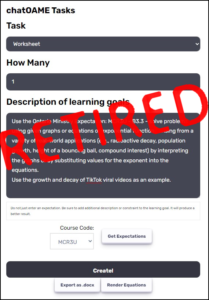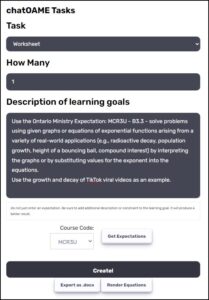Now, as a math teacher, “differentiation of product” means something completely different… but for this purpose it means — don’t expect every student to respond to your request for evidence of understanding with the same learning artefact.
This is well stolen from Vanderbilt University (https://iris.peabody.vanderbilt.edu/module/di/cresource/q2/p07/ )
Now, even as a first year teacher way back in the 90s before I really knew about differentiation of product, I encouraged students to present their mathematics projects as diversely as possible. But OneNote has truly given them complete freedom and ease of submission.
- Inking — first & foremost, student mathematical work tends to be handwriting. Most of my students don’t know LaTeX (although I have had a few of my students, from Grade 9 and up, learn it once they were told it existed and was what ‘real’ mathematics authors use. Interestingly, OneNote (and Word & PowerPoint) supports LaTeX. OneNote has made it far simpler and more efficient for students to present their mathematical work — OneNote lets them move writing around, highlight, annotate all within the same space.
- Ink to Math — some teachers (and some students) prefer type-set mathematics. Without having to turn to LaTeX or a plug-in equation editor, OneNote will automatically typeset your hand-written mathematical notation into editable math text.
- Images — students sometimes like to work on paper, whiteboard or window (glass works great!) or they want to show all of their brainstorming or rough work in their archive. Using the OfficeLens App on their phones (iPhone, Android, Microsoft), they can push all of this physical content without any work at all — and OfficeLens cleans & straightens their images automatically. This speeds up the process, as there is no need for image work by the student to make things look great.
In fact, OfficeLens is such an important part of our student evidence collection that it drove which device we chose for our 1:1 program — having a rear-facing camera was critical (We use a Fujitsu T938 but the Microsoft Surface has a rear camera as well).
- Audio — I have had students write little songs for some of their work. OneNote lets students capture audio and embed it directly into the OneNote page (no add-ins, no linked files to lose). The students have also used this option to augment their written work, to provide additional commentary.
- Video — Like Audio, students can embed either recorded video, or capture themselves talking about their mathematics and have everything embedded into the OneNote page (again, no files to lose or links to get wrong). You can see the VLC icon (the striped safety pylon) showing the video embedded in the page below.

Here a student inked their solution, checked it in Desmos AND added a video of suggestions on how else to solve this problem. - ANY file — OneNote accepts any file onto its page, so there is no need for worrying about emailing or sharing files, or uploading them. The student can do whatever they want, and just drop the file onto the page. The teacher automatically gets them to view & assess. You just don’t think about “files” anymore. Everything is there on the student page so it’s completely wide open what they may want to do. It’s very liberating for both student and teacher.
The important thing is to give student choice … by giving them choice, you give them voice. Not everyone wants to just write their mathematics and be done with it. OneNote gives them the easiest way to do anything they want. And, with teachers using the ClassNotebook, it’s all there ready to be assessed and given feedback in a smooth and easy way for the teacher. More on that later.





